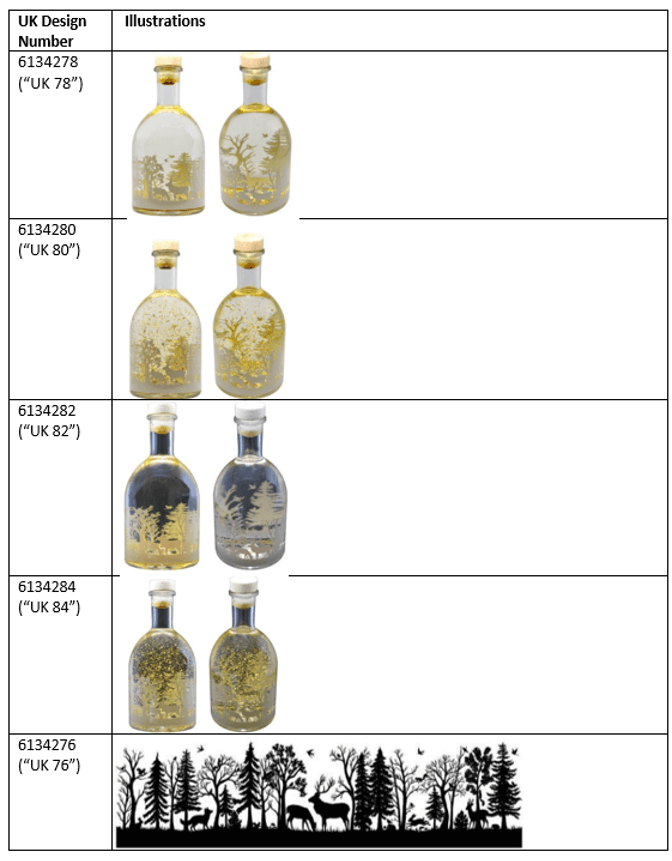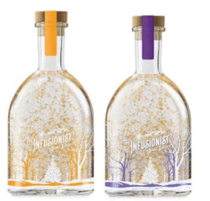
M&S all lit up in successful liqueur bottle UK registered design case
Successful M&S bottle registered design case against Aldi
In a successful M&S bottle design case against Aldi, the Intellectual Property Enterprise Court (IPEC) ruled that Aldi’s bottles were infringing four of its registered designs.
Background
In autumn 2020, Marks & Spencer (“M&S“) launched a festive gin-liqueur which proved to be very popular with consumers. M&S had registered the design of the bottles, including the winter scene design and LED light at the base of the bottle that illuminates the content when turned on. The gin also contained gold flakes which suspended in the liqueur when shaken.
In November 2021, Aldi started to sell gin-liqueurs called “Infusionist”. They contained gold flakes in a light-up bottle.
An action was brought against Aldi for infringement of its registered designs.
M&S registered designs
M&S relied on the following registered designs, which all have the priority registration date of 15 December 2020 (although the last one was not discussed at the trial):

Aldi’s bottles
Aldi’s liqueurs came in two flavours, clementine, and blackberry. The bottles looked like this:

IPEC’s decision
Hacon J first considered what M&S’ design registrations actually included and importantly, whether or not the LED light aspect of the design was part of the design registration. The Judge held that the two designs with the dark background featured the integral light feature but the other two designs did not.
To assess if there had been an infringement of M&S’s registered designs under section 7 of the Registered Designs Act 1949, Hacon J considered the following factors:
- The relevant sector that the products incorporating the designs belong;
- Who the informed user of the products is, and their level of attention to the designs;
- The designer’s degree of freedom in developing the design; and
- The overall impressions produced by the designs on the informed user.
1. Relevant sector
Hacon J considered that the relevant sector was spirits and liqueurs in the UK. He rejected M&S’ argument that it should be Christmas liqueur in the UK, which was too narrow. Although the images of the designs do suggest winter, the products could be sold in any month.
2. Informed user
It was not in dispute that the informed user would be a member of the UK public who purchases and consumes spirits and liqueurs (rather than a commercial buyer for the sellers of such product).
3. Designer’s degree of freedom
Hacon J found that the designer had considerable freedom in designing the bottles, particularly for the shape of the bottle and the design to be printed on it.
He then considered whether there were any features that were solely dictated by technical function. Whilst Aldi argued that this was the case, Hacon J held that the gold flakes, curvature of the bottle and integrated light were all aesthetic choices that had no sole technical function for the purpose of the design.
4. Overall impression
As part of its case, Aldi argued that the words on the front of its gin bottle “The INFUSIONIST Small Batch” distinguished its bottle from M&S’s registered designs. However, the Judge found that this wording was not clear enough to make an impression, and that it made no difference overall to the comparison of the designs.
Aldi argued that M&S’s registered designs only offered a narrow scope of protection because, a) M&S had released similar bottle designs in previous years; or b) there were similar bottle designs already in existence. Hacon J disagreed with this argument, stating that whilst some gin bottles may have a similar shape, none have a snow effect or an integrated LED light.
As a result, the Judge concluded that the informed user would notice that:
- The two bottles and their respective stoppers had an identical shape;
- Both designs contained a winter scene consisting mostly of tree silhouettes; and
- Both used a snow effect and an integrated light at the bottom of the bottle.
Cumulatively these similarities would be “striking”. The differences were “relatively minor”, and not sufficient to produce a different overall impression. Consequently, Hacon J concluded that Aldi’s products infringed M&S’s registered designs.
Key takeaways
The case is a useful reminder that registered design protection is an important tool against lookalike products. Careful consideration must be given to what is actually included in the design registration itself. Where features are particularly novel in a design, it is important to ensure they are properly captured within the registration, even if photographs are used.








